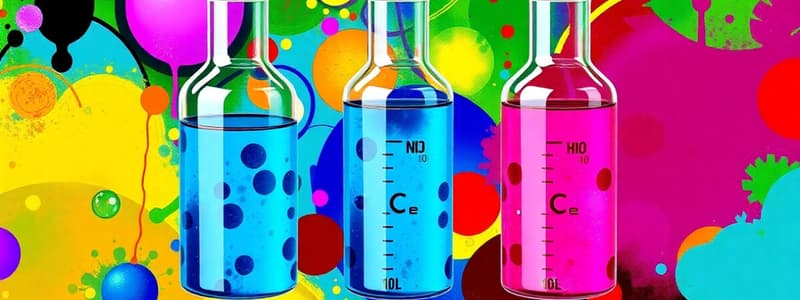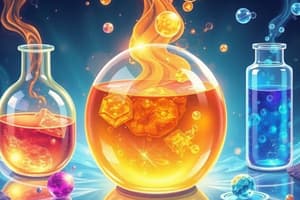Podcast
Questions and Answers
In a solution containing both $NaF$ and $HF$, the addition of $NaF$ affects the equilibrium of the $HF$ dissociation. According to Le Chatelier's Principle, what is the primary effect of adding $NaF$?
In a solution containing both $NaF$ and $HF$, the addition of $NaF$ affects the equilibrium of the $HF$ dissociation. According to Le Chatelier's Principle, what is the primary effect of adding $NaF$?
- It increases the ionization of $HF$ by neutralizing the $H_3O^+$ in the solution.
- It causes the reaction to shift towards the reactants, decreasing the ionization of $HF$. (correct)
- It causes the reaction to shift towards the products, increasing the concentration of $H_3O^+$
- It has no effect on the equilibrium because $NaF$ is a salt and does not participate in the acid dissociation.
A buffer solution is prepared containing a weak acid and its conjugate base. How does this buffer system function to resist changes in pH upon the addition of a strong acid or a strong base?
A buffer solution is prepared containing a weak acid and its conjugate base. How does this buffer system function to resist changes in pH upon the addition of a strong acid or a strong base?
- The weak acid and conjugate base react with each other to neutralize the effects of added acids or bases.
- The weak acid neutralizes added hydroxide ions ($OH^−$), while the conjugate base neutralizes added hydronium ions ($H_3O^+$).
- The weak acid neutralizes added hydronium ions ($H_3O^+$), while the conjugate base neutralizes added hydroxide ions ($OH^−$). (correct)
- The buffer system dilutes the added acid or base, minimizing the change in pH.
Consider a buffer solution made from $HF$ (hydrofluoric acid) and $NaF$ (sodium fluoride). Which statement accurately describes how this buffer resists changes in pH?
Consider a buffer solution made from $HF$ (hydrofluoric acid) and $NaF$ (sodium fluoride). Which statement accurately describes how this buffer resists changes in pH?
- $HF$ neutralizes added bases, while $F^−$ from $NaF$ neutralizes added acids. (correct)
- The $Na^+$ ions from $NaF$ neutralize acids, while $HF$ prevents the solution from becoming too basic.
- $HF$ neutralizes added acids, while $F^−$ from $NaF$ neutralizes added bases.
- Both $HF$ and $NaF$ work together to dilute any added acids or bases.
A solution is prepared by mixing $NH_3$ (ammonia) and $HCl$ (hydrochloric acid). How does this mixture function as a buffer solution?
A solution is prepared by mixing $NH_3$ (ammonia) and $HCl$ (hydrochloric acid). How does this mixture function as a buffer solution?
What is the primary utility of the Henderson-Hasselbalch equation in acid-base chemistry?
What is the primary utility of the Henderson-Hasselbalch equation in acid-base chemistry?
Which statement accurately describes the 'equivalence point' in the context of a titration experiment?
Which statement accurately describes the 'equivalence point' in the context of a titration experiment?
In a titration experiment, the 'end point' is determined by a visual change, often indicated by a color change of an indicator. What is the significance of the end point in relation to the equivalence point?
In a titration experiment, the 'end point' is determined by a visual change, often indicated by a color change of an indicator. What is the significance of the end point in relation to the equivalence point?
During the titration of a weak acid with a strong base, which type of reaction table is most appropriate for calculating the pH at a point before the equivalence point is reached?
During the titration of a weak acid with a strong base, which type of reaction table is most appropriate for calculating the pH at a point before the equivalence point is reached?
What is the significance of the solubility product constant, $K_{sp}$, in the context of solubility equilibria?
What is the significance of the solubility product constant, $K_{sp}$, in the context of solubility equilibria?
What is 'molar solubility' and how is it defined?
What is 'molar solubility' and how is it defined?
In what way does the presence of a common ion affect the solubility of a salt?
In what way does the presence of a common ion affect the solubility of a salt?
Besides the common ion effect, what other factors can influence the solubility of a salt in a solution?
Besides the common ion effect, what other factors can influence the solubility of a salt in a solution?
Under what condition does precipitation occur in a solution, and how is the reaction quotient, Q, used to determine if precipitation will happen?
Under what condition does precipitation occur in a solution, and how is the reaction quotient, Q, used to determine if precipitation will happen?
How does the common ion effect, as described by Le Chatelier's Principle, influence the solubility of a sparingly soluble salt in solution?
How does the common ion effect, as described by Le Chatelier's Principle, influence the solubility of a sparingly soluble salt in solution?
What is the implication of a high $K_{sp}$ value for a given ionic compound?
What is the implication of a high $K_{sp}$ value for a given ionic compound?
How does temperature generally affect the solubility of most ionic compounds, and what is the underlying principle behind this effect?
How does temperature generally affect the solubility of most ionic compounds, and what is the underlying principle behind this effect?
Consider a solution containing $AgCN$, where $CN^−$ is the conjugate base of the weak acid $HCN$. How would increasing the pH of the solution affect the solubility of $AgCN$?
Consider a solution containing $AgCN$, where $CN^−$ is the conjugate base of the weak acid $HCN$. How would increasing the pH of the solution affect the solubility of $AgCN$?
For a salt $MX$ dissolving in water, with a $K_{sp}$ expression of $K_{sp} = [M^+][X^-]$, if the concentration of $M^+$ is increased by the addition of a soluble compound containing $M^+$, how will the concentration of $X^-$ change to maintain equilibrium and satisfy the $K_{sp}$?
For a salt $MX$ dissolving in water, with a $K_{sp}$ expression of $K_{sp} = [M^+][X^-]$, if the concentration of $M^+$ is increased by the addition of a soluble compound containing $M^+$, how will the concentration of $X^-$ change to maintain equilibrium and satisfy the $K_{sp}$?
In the titration of a polyprotic acid, multiple equivalence points may be observed. What does each equivalence point signify?
In the titration of a polyprotic acid, multiple equivalence points may be observed. What does each equivalence point signify?
During a titration, why is it crucial to select an indicator whose color change occurs as close as possible to the equivalence point?
During a titration, why is it crucial to select an indicator whose color change occurs as close as possible to the equivalence point?
When titrating a weak acid with a strong base, the pH at the half-equivalence point is particularly significant. What does this pH value correspond to directly?
When titrating a weak acid with a strong base, the pH at the half-equivalence point is particularly significant. What does this pH value correspond to directly?
Consider the titration of a weak base with a strong acid. Which of the following statements accurately describes the composition of the solution at the equivalence point?
Consider the titration of a weak base with a strong acid. Which of the following statements accurately describes the composition of the solution at the equivalence point?
How does the presence of a buffer system in a solution affect the shape of a titration curve, particularly when titrating a weak acid with a strong base?
How does the presence of a buffer system in a solution affect the shape of a titration curve, particularly when titrating a weak acid with a strong base?
When comparing the titration curves of a strong acid with a strong base and a weak acid with a strong base, what is a key difference in their shapes that indicates the strength of the acid being titrated?
When comparing the titration curves of a strong acid with a strong base and a weak acid with a strong base, what is a key difference in their shapes that indicates the strength of the acid being titrated?
Why is the selection of an appropriate indicator critical in performing accurate titrations, especially when dealing with weak acids or weak bases?
Why is the selection of an appropriate indicator critical in performing accurate titrations, especially when dealing with weak acids or weak bases?
In a buffer solution composed of a weak acid and its conjugate base, what determines the buffer capacity of the system?
In a buffer solution composed of a weak acid and its conjugate base, what determines the buffer capacity of the system?
How does the addition of a strong acid to a buffer solution containing a weak base and its conjugate acid affect the equilibrium, and which component of the buffer system neutralizes the added acid?
How does the addition of a strong acid to a buffer solution containing a weak base and its conjugate acid affect the equilibrium, and which component of the buffer system neutralizes the added acid?
Flashcards
Common Ion Effect
Common Ion Effect
When a solution has two substances sharing a common ion, reducing solubility/ionization of one. A product addition shifts the reaction to use up the excess, moving towards reactants.
Buffer Solution
Buffer Solution
A solution resisting pH change with small acid/base additions. Contains acid and conjugate base, neutralizing added bases/acids.
HF and NaF as Buffer
HF and NaF as Buffer
HF (weak acid) can neutralize added bases; NaF (conjugate base) neutralizes added acids. Maintains stable pH.
NH3 and HCl as Buffer
NH3 and HCl as Buffer
Signup and view all the flashcards
Henderson-Hasselbalch equation
Henderson-Hasselbalch equation
Signup and view all the flashcards
Titration
Titration
Signup and view all the flashcards
Titrant
Titrant
Signup and view all the flashcards
Equivalence Point
Equivalence Point
Signup and view all the flashcards
End Point
End Point
Signup and view all the flashcards
Indicator
Indicator
Signup and view all the flashcards
Solubility Product Constant (Ksp)
Solubility Product Constant (Ksp)
Signup and view all the flashcards
Molar Solubility
Molar Solubility
Signup and view all the flashcards
Common Ion Effect on Solubility
Common Ion Effect on Solubility
Signup and view all the flashcards
Factors Affecting Solubility
Factors Affecting Solubility
Signup and view all the flashcards
Precipitation Conditions
Precipitation Conditions
Signup and view all the flashcards
Study Notes
Common Ion Effect
- The common ion effect occurs when a solution contains two substances sharing a common ion
- This presence reduces the solubility or ionization of one or both substances
- Le Chatelier's Principle explains this: adding more of a product (common ion) shifts the reaction towards the reactants
Buffer Solutions
- Buffer resists pH changes upon adding small amounts of acids or bases
- Buffers contain both an acid and its conjugate base or a base and its conjugate acid
- The base component reacts with added acid, and the acid component reacts with added base, maintaining a stable pH
HF and NaF as a Buffer
- HF is a weak acid
- NaF provides F-, its conjugate base
- Together, HF and F- neutralize added bases and acids respectively, stabilizing pH.
NH3 and HCl as a Buffer
- NH3 (ammonia) is a weak base
- Reacting with HCl forms NH4+, the conjugate acid
- NH3 neutralizes added acids
- NH4+ neutralizes added bases
- Both resist pH changes
Henderson-Hasselbalch Equation
- Calculates the pH of a buffer
- A slower method involves determining moles of conjugate acid/base after adding strong acid/base
- Then using volumes to calculate concentrations
- An ICE table is then used, followed by solving for E concentrations to calculate pH
Titration Terminology
- Titration introduces one solution slowly to another until the reaction completes, often for concentration determination
- Titrant is the solution added from a burette
- Equivalence Point is when the amount of acid equals the amount of base, indicating complete reaction
- End Point is when the indicator changes color, signaling titration completion, ideally near the equivalence point
- Indicator is a substance changing color at a specific pH to show the titration's end.
Titration Curves
- Strong acid, strong base titration curves can be found in textbook figure 17.3
- Weak acid, strong base titration curves can be found in textbook figure 17.4
- Strong acid, weak base titration curves can be found in textbook figure 17.6
Reaction Tables
- Use an ICE table with molarities for weak acid or base solutions, as they are equilibrium systems
- This applies at the beginning of titration (before titrant addition) or at the equivalence point
- Use a reaction table in moles for mixtures of weak acid/base with strong acid/base during titration
- Strong acid/base presence means the reaction goes to completion (straight arrow)
- Dr. J uses an SRFC table; textbook example is in problem 17.4
Solubility Product Constant (Ksp)
- Ksp indicates how soluble a compound is in water
- It's the product of ion concentrations in a saturated solution, each raised to its coefficient power
Molar Solubility
- Molar solubility defines the number of moles of compound dissolving in 1 liter of water before saturation
Ksp and Molar Solubility Relationship
- Use an ICE table to calculate one from the other
- Molar solubility equals ‘x’ in the ICE table, which can be used to find Ksp
- With a given Ksp, set up and solve the ICE table for 'x' to find molar solubility
Common Ion Effect on Salt Solubility
- The common ion effect decreases salt solubility
- If a shared ion is already in the solution, less salt dissolves
- The equilibrium shifts towards the undissolved salt side per Le Chatelier's principle
Factors Affecting Salt Solubility
- Temperature increases solubility, but not always
- Changes in pH affect salts with acidic/basic ions
- Consider the effect of pH on the amount of that ion if one of the ions is a conjugate of a weak acid or base
Precipitation Conditions
- Precipitation occurs when the product of ion concentrations exceeds Ksp
- The reaction quotient Q helps determine precipitation
- A precipitate forms if Q > Ksp
Studying That Suits You
Use AI to generate personalized quizzes and flashcards to suit your learning preferences.
Related Documents
Description
Explanation and examples of the common ion effect and buffer solutions. Buffers resist pH changes with an acid and conjugate base. Examples include HF and NaF or NH3 and HCl.



